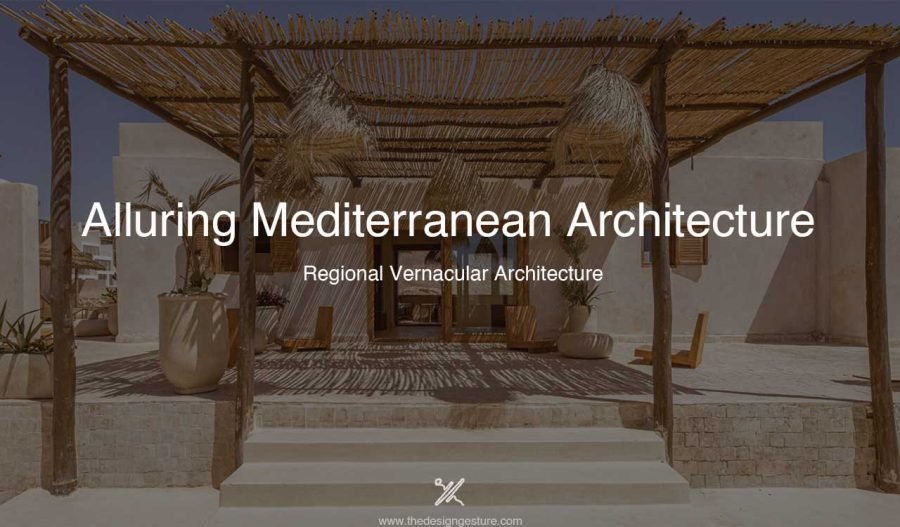Traditional and indigenous construction styles and practices that have evolved over time in certain regions or locales are referred to as vernacular architecture. It reflects the cultural, environmental, and historical aspects of a certain location. Vernacular architecture varies significantly across the globe, reflecting the numerous influences and unique qualities of different locations.
Mediterranean architecture is inspired by historic European architecture and is reminiscent of sun-drenched seaside regions. Red roof tiles, stucco walls, arches, and enclosed outdoor patios are common features of the exquisite exteriors of Mediterranean architecture. The architecture is associated with warm and outdoor living, emphasizing an aesthetical and sophisticated lifestyle.
Vernacular architecture is approached differently in different parts of the world, with various design concepts, building processes, and materials affected by the local environment, and culture, and inspired by history. Europe has some of the most distinct regional variations in the history of its vernacular architecture. Because of its lengthy and complicated history, the continent has a wide range of architectural styles.
Although Mediterranean architecture was first inspired by Italy, Portugal, Spain, and other countries surrounding the Mediterranean Sea, influences from France, Greece, and Morocco, among others, joined the mix over time. Because so many cultures have influenced Mediterranean architecture, it is also known as Spanish Colonial, Moroccan, Mission Revival, and Neo-Mediterranean, among other titles.
Table of Contents
History of Mediterranean Architecture
The Mediterranean means land or country in the middle. The Mediterranean gets its name from the Latin term “Mediterranean,” which means “inland” or “in the middle of the land.” This sea was a vital commercial and cultural exchange route for the Egyptians, Ancient Greeks, Ancient Romans, and the Middle East.
Mediterranean history played an important role in the birth and development of Western civilization. The Mediterranean Sea was an important commerce and travel route for ancient traders and travelers, allowing economic and cultural exchanges between the people who arrived in the region. Understanding the origins and evolution of many modern societies requires an understanding of the history of the Mediterranean region.
Early Mediterranean-styled buildings, like many architectural styles, were built with materials that were accessible to builders, such as adobe with a textured, stucco finish and clay for their distinctive, red roof tiles.
The Mediterranean Revival homes and buildings that we are aware of today were designed to capture the warmth, luxury, and leisure of a Mediterranean architecture villa. Although the style was initially intended for public spaces such as hotels and coastal resorts, American architects in Florida and California promoted it. They believed the slow manner complemented the temperatures and habits of the regions. The Mediterranean Revival style enjoyed a major boom in the 1920s, as Americans were obsessed with wealth and leisure and desired their homes to reflect those ideals.
Styles of Mediterranean Architecture
Italian Renaissance
This style of Mediterranean villa, with arches and columns, is heavily influenced by the Italian Renaissance of the 16th century. The most opulent and majestic form of Mediterranean dwelling. The style is distinctive of the material and elements inspired by the history and geographic location. This style is more of a formal appeal as compared to other styles.
Spanish Revival
Spanish Colonial style is a simpler and more rustic form of Mediterranean style that draws inspiration from the architectural principles developed by Spanish settlers in the time of 16th-century America. Spanish Colonial dwellings are primarily characterized by one-story structures with simple, clean lines and a low-pitched clay roof. The more the architecture is simple, adds to being in a sophisticated environment.
The detailing of Spanish Revival can be observed with its details of balconies, tiles, and mostly outdoor living which is mainly to enjoy the open spaces. Arcades are an insignificant detail of this architectural design style.
Modern Mediterranean
Modern Mediterranean architecture, with its emphasis on resort-style living, can incorporate a variety of cultural influences. Modern Mediterranean homes frequently include large, open floor designs, enormous kitchens, and indoor-outdoor living.
Elements of Mediterranean Architecture
The indistinctive characters that reflect Mediterranean architecture can be followed as;
Symmetrical Facades
The majority of Mediterranean houses are one to two stories with large and vast, symmetrical exteriors. The entrance door is usually places in the center of the home, surrounded by towering wrought-iron guarded windows. The Mediterranean design emphasizes bringing the outdoors inside, so there are multiple big doors and windows that lead to the home’s outdoor living space. The design brings the idea of beach life inside the house.
Roof Tiles
As the houses were built from locally available materials, one of these is roof tiles. The tiles are shaped like a half tube made of red clay. The shape is not only because it drains water but also because it also stores cold air inside during summer. Mediterranean style with sloping ceilings might be two sides (saddle) or four sides.
Stucco Walls
Exterior and interior stucco walls are typical in locations of Mediterranean places with warm, dry weather. These thick walls can better preserve the interior’s cool air on hot days. When temperatures drop at night, they gradually release the warmth accumulated during the day into the home.
Archways
Archways are frequently built around Mediterranean windows and doors. These arches are occasionally embellished with bright hand-made tiles or mosaic glass.
Outdoor Living Spaces
Mediterranean houses mix perfectly with their surroundings. Most houses have an outdoor living space, such as a patio, terrace, balcony, or atrium, as well as multiple entry points to the outside.




